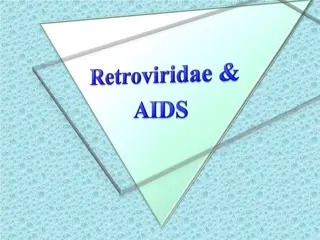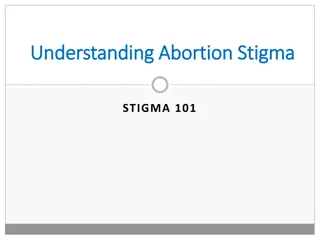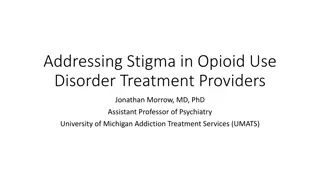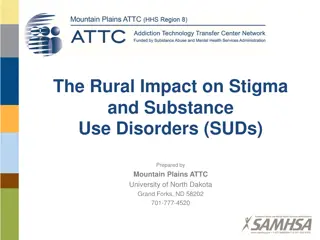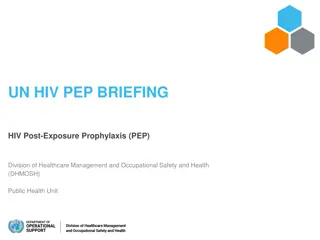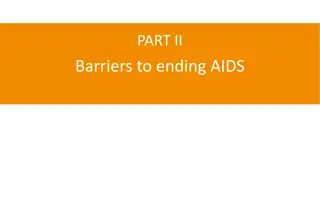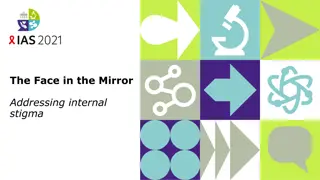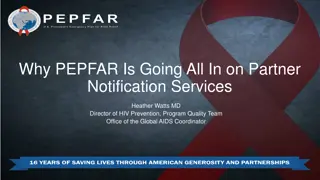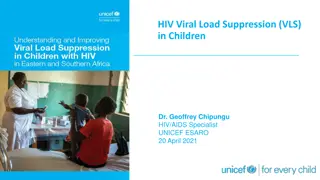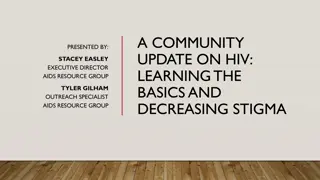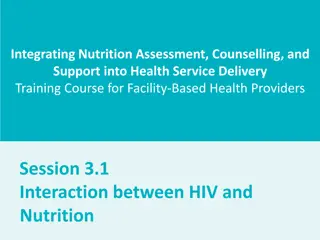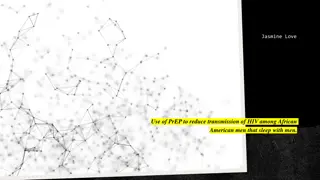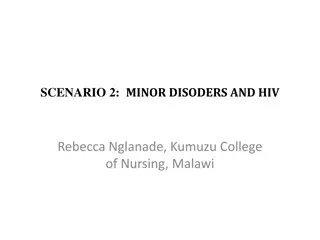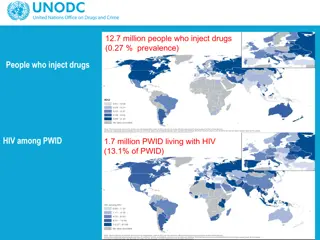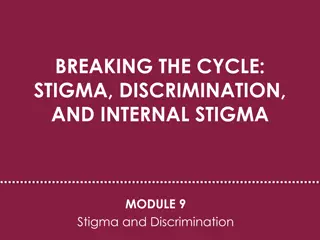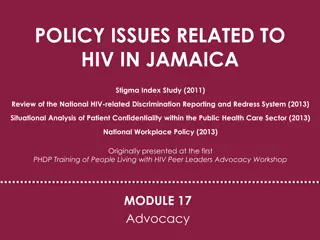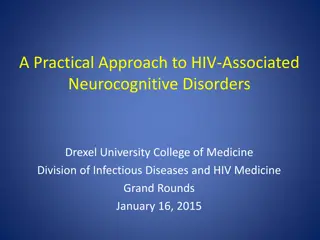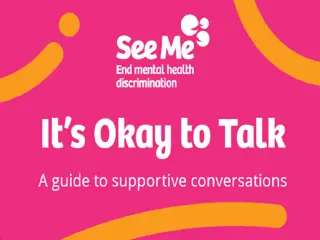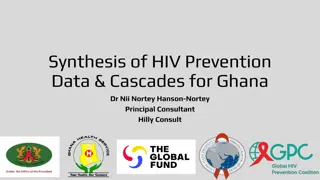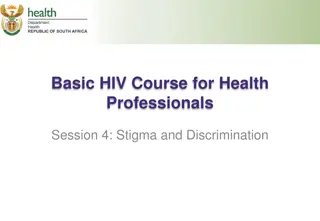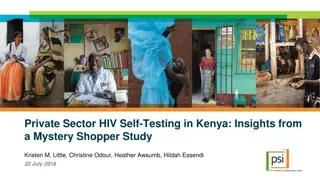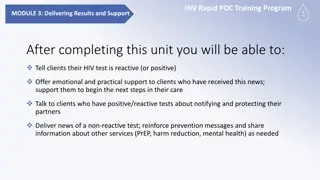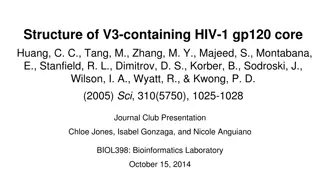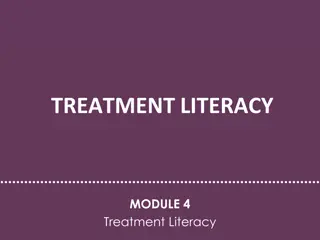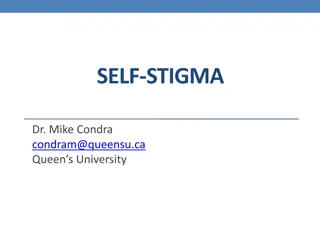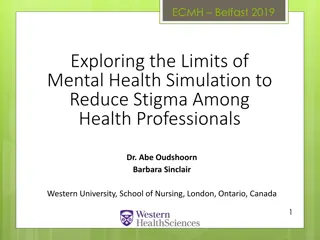Understanding and Combatting Mental Health Stigma
Explore the WISE approach to reducing mental health stigma by increasing inclusion, hope, and support. Learn about the types of stigma, stigmatizing ideas and actions, self-stigma, and the ongoing impact of stigma on individuals. Discover how education can play a crucial role in changing societal vi
1 views • 29 slides
Update on HIV and AIDS Prevention Guidelines 2022
This update highlights key points from the PMK No. 23/2022 on combating HIV, AIDS, and STIs. It covers terminologies, goals for eliminating HIV and AIDS by 2030, and strategies such as PrEP and PEP. The guidelines emphasize timely interventions like Post-Exposure Prophylaxis (PEP) and Pre-Exposure P
3 views • 38 slides
Understanding the Differences Between HIV and AIDS, Importance of Prevention
HIV and AIDS are closely related, with HIV being the virus that leads to AIDS. HIV weakens the immune system by attacking specific white blood cells, while AIDS is the advanced stage of HIV infection. Prevention is crucial as AIDS is a deadly, incurable disease. The transmission of HIV primarily occ
4 views • 14 slides
Human Immunodeficiency Virus
HIV, a member of the lentivirus subfamily of retroviruses, causes Acquired Immunodeficiency Syndrome (AIDS). HIV-1 and HIV-2 have distinct characteristics, with HIV-1 being global and HIV-2 primarily in West Africa. The virus encodes reverse transcriptase and has an envelope containing glycoproteins
1 views • 31 slides
Understanding Abortion Stigma - Insights and Implications
The content delves into the complexities of abortion stigma, exploring key definitions, effects of stigma on women's wellbeing, and reflections on its existence across time and location. It addresses why abortion is stigmatized, different levels of stigma, and the impact on individuals, communities,
0 views • 26 slides
Understanding and Addressing Stigma in Opioid Use Disorder Treatment Providers
This presentation by Dr. Jonathan Morrow highlights the stigma surrounding opioid use disorder treatment, focusing on identifying causes of stigma, using de-stigmatizing language, addressing stigmatizing behaviors, and reducing stigma at an institutional level. It discusses the types and effects of
0 views • 25 slides
Impact of Stigma and Substance Use Disorders in Rural Areas
Rural communities face challenges related to stigma and substance use disorders, including limited transportation and treatment options. Stigma may be heightened in these areas due to privacy concerns and lack of confidentiality. Initiating evidence-based methods and implementing harm reduction stra
0 views • 14 slides
Understanding HIV Post-Exposure Prophylaxis (PEP) and Prevention
HIV Post-Exposure Prophylaxis (PEP) is a crucial emergency medical response for individuals exposed to HIV, aiming to prevent infection. It involves a regimen of medications, tests, and counseling services initiated within 72 hours of exposure. HIV transmission occurs through body fluids like blood,
3 views • 27 slides
TB and HIV Overview for World TB Day March 2022
This content provides an overview of the relationship between TB and HIV, emphasizing the importance of testing HIV patients for latent TB infection and TB patients for HIV. It also outlines the guidelines for managing these co-infections, including diagnostic tests, treatment strategies, and patien
0 views • 17 slides
Challenges in Addressing HIV Stigma and Discrimination
Despite a decline in stigma associated with HIV, discriminatory attitudes persist globally, impacting access to healthcare and social inclusion. Data reveals variances in attitudes towards people living with HIV across different regions and highlights the need to address discrimination within health
0 views • 29 slides
Understanding Self-Stigma in HIV: Causes and Impacts
Self-stigma in the context of HIV involves negative beliefs, thoughts, and behaviors that can lead to shame, guilt, and self-rejection. This article explores the cycle of self-stigma, differences between stigma and discrimination, causes of self-stigma, and its impact on individuals. Addressing inte
0 views • 12 slides
PEPFAR's Focus on Partner Notification Services for HIV Prevention
PEPFAR is intensifying efforts on partner notification services for HIV prevention to address the global issue of undiagnosed HIV cases. The initiative aims to improve testing strategies, increase testing volumes, and enhance epidemic control. By reaching HIV testing targets and implementing efficie
0 views • 24 slides
Addressing Viral Load Suppression in Children with HIV: Insights and Recommendations
This study led by Dr. Geoffrey Chipungu, an HIV/AIDS Specialist at UNICEF ESARO, explores the rates, trends, and factors associated with HIV viral load suppression (VLS) in children. The research reveals sub-optimal VLS rates in children compared to adults, highlighting the need for improved policie
5 views • 12 slides
Understanding HIV: Basics, Stages, and Treatment
HIV, Human Immunodeficiency Virus, attacks the immune system and can progress to AIDS if left untreated. Antiretroviral Therapy (ART) helps control HIV, allowing individuals to live healthy lives. The stages of HIV include Acute Infection, Chronic Infection, and the most severe stage, AIDS. Early de
0 views • 29 slides
Exploring Stigma in Early Detection of Psychosis Among Young People
This research focuses on stigma associated with identifying at-risk individuals for psychosis. It delves into the impact of societal perceptions on mental health outcomes, presenting findings from studies on public stigma, discrimination, and self-stigma. The study also examines how cultural factors
0 views • 46 slides
HIV Rapid Test Procedures and Instructions
This content provides detailed instructions for conducting HIV rapid tests using three different kits: Determine HIV-1/2 Rapid Test, Uni-Gold HIV-1/2 Rapid Test, and Bioline HIV-1/2 Rapid Test. The instructions include steps such as specimen collection, test device preparation, result interpretation
0 views • 5 slides
Overview of Ryan White CARE Act: 30 Years of Lifesaving Care for People Living with HIV/AIDS
August 18, 2020, marked the 30th anniversary of the Ryan White CARE Act, a landmark legislation that established the Ryan White HIV/AIDS Program providing care and treatment services to individuals with HIV in the U.S. The Act has been amended several times to extend and revise its purpose, no longe
0 views • 21 slides
Understanding the Impact of HIV on Nutrition
This training session focuses on the relationship between undernutrition and HIV, discussing how HIV/AIDS affects nutrition among People Living with HIV (PLHIV). It covers the benefits of good nutrition for PLHIV and provides recommendations for Nutrition Assessment, Counselling, and Support (NACS)
1 views • 27 slides
Exploring the Use of PrEP to Reduce HIV Transmission Among African American Men
In response to the HIV/AIDS pandemic, this study focuses on the effectiveness of Pre-Exposure Prophylaxis (PrEP) in reducing HIV transmission among African American men who have sex with men in Orangeburg, SC. The research aims to investigate the impact of PrEP compared to condom use, and the necess
0 views • 6 slides
Challenges Faced by Pregnant Women with HIV Diagnosis in Malawi
Maria, a pregnant woman in Malawi, faces the challenge of an unexpected pregnancy and a positive HIV diagnosis. The scenario explores her concerns, midwifery diagnosis, preparation for HIV testing, disclosure of results, and maintaining confidentiality in antenatal care. It also delves into factors
0 views • 10 slides
Global Impact of HIV Among People Who Inject Drugs
12.7 million people worldwide inject drugs, with 1.7 million of them living with HIV. The prevalence of HIV among people who inject drugs is 13.1%, highlighting the need for comprehensive service provision including testing, needle programs, opioid therapy, and antiretroviral treatment. The data als
0 views • 4 slides
Role of REG3 and I-FABP in HIV-Related Gut Permeability and Inflammation
This presentation highlights the significance of Regenerating Islet-Derived Protein-3 (REG3) and Intestinal Fatty Acid Binding Protein (I-FABP) in microbial translocation, inflammation, and reservoir size in individuals living with HIV. REG3 and I-FABP serve as markers of gut epithelial damage and p
0 views • 7 slides
Understanding Stigma, Discrimination, and Internal Stigma
Stigma is the devaluation of individuals based on specific attributes such as race, HIV status, or gender, leading to discrimination and internalized feelings of shame and worthlessness. HIV-related stigma, discrimination, and internal stigma can have detrimental effects on individuals and communiti
0 views • 12 slides
HIV-Related Stigma and Discrimination in Jamaica: A Policy Review
Conducted in 2011 and 2013, this study in Jamaica explores the stigma, discrimination, and support experiences of individuals living with HIV. Findings highlight high levels of internalized stigma, experiences of exclusion and harassment, and challenges in disclosure. The study also assesses support
0 views • 38 slides
Impact of Global Declines in HIV Testing and Service Disruptions on Future Healthcare
Global declines in HIV testing and reductions in new initiators, coupled with disruptions in HIV services due to COVID-19, pose challenges for future healthcare. Short-term disturbances could lead to increased HIV-related mortality, emphasizing the need for program responses to mitigate adverse effe
0 views • 10 slides
Understanding HIV-Associated Neurocognitive Disorders: A Practical Approach
HIV/AIDS presents complex medical and psychiatric challenges, including HIV-Associated Neurocognitive Disorders (HANDs), which impact patients, families, and caregivers. This presentation by Dr. Mary Ann Adler Cohen provides insights into the prevalence, impact, diagnosis, and treatment of HANDs, em
0 views • 56 slides
Resistance Analysis of Long-Acting Lenacapavir in HIV Treatment: 104-Week Findings
Study on long-acting lenacapavir in heavily treatment-experienced HIV individuals after 104 weeks revealed emergence of lenacapavir resistance-associated mutations. Lenacapavir, a potent HIV-1 capsid inhibitor, has shown activity against ARV-resistant strains. The CAPELLA study analyzed lenacapavir
0 views • 11 slides
Supportive Conversations Workshop: Understanding Mental Health Stigma
Explore the concepts of mental health stigma and discrimination in a workshop setting. Gain awareness of the impact of stigma, feel more confident in discussing mental health, and create a safer space for open dialogue. Learn to challenge stigma and discrimination, and hear personal experiences that
0 views • 36 slides
Comprehensive Overview of HIV Prevention Strategies and Interventions
This synthesis covers the importance of monitoring progress in HIV prevention through data cascades, the need for standardized frameworks, promoting effective HIV prevention programs in diverse social contexts, and the key pillars of combination HIV prevention strategies. It also outlines various HI
0 views • 40 slides
Understanding HIV-Related Stigma and Discrimination
This session covers the definition and types of stigma and discrimination related to HIV/AIDS, along with the impact on people living with HIV/AIDS (PLWHA). Participants will also learn strategies to address stigma and its effects on prevention and treatment efforts, emphasizing the need to combat s
0 views • 10 slides
Basic HIV Course for Health Professionals Session 1: Introduction to HIV
This session introduces basic epidemiological concepts, differentiates between HIV and AIDS, explains the HIV life cycle, and discusses how HIV is transmitted. Definitions of key terms like prevalence, incidence, mortality rate, and morbidity are provided. The session also highlights the differences
0 views • 30 slides
Insights into Private Sector HIV Self-Testing in Kenya
A mystery shopper study was conducted to assess the private sector's effectiveness in providing high-quality HIV self-testing services to adolescents and young people in Kenya. The study focused on pharmacies and private health facilities participating in an HIV self-testing demonstration project. M
0 views • 25 slides
HIV Rapid POC Training Program - Delivering Results and Support
In Module 3 of the HIV Rapid POC Training Program, you will learn how to handle delivering reactive (or positive) HIV test results to clients. It covers providing emotional support, discussing next steps in care, notifying and protecting partners, and reinforcing prevention messages. The module emph
1 views • 13 slides
Understanding the Role of V3 Region in HIV Entry to CD4 T-Cells
The V3 region of gp120 plays a crucial role in HIV entry to CD4 T-cells by determining the coreceptor usage. Studies focus on the structural aspects of V3, its conservation, coreceptor binding, and antibody accessibility. The HIV envelope structure, including trimeric spikes with gp120 and gp41 glyc
0 views • 24 slides
Assessment of HIV Prevention Programme Needs and Barriers in Ghana
Conduct a data-driven assessment of HIV prevention programme needs and barriers in Ghana based on the Ghana Road Map Baseline Survey components. Evaluate the country's preparedness in addressing HIV epidemic patterns and prevention response analysis. Identify key barriers hindering HIV prevention ef
0 views • 11 slides
Understanding HIV and AIDS: The Progression in Adult Natural History
HIV infection progresses in stages from acute infection with flu-like symptoms to a latency period of no symptoms, then advancing to AIDS where the immune system is significantly weakened, leading to opportunistic infections and HIV-related cancers. The virus targets CD4 cells, impacting the immune
0 views • 29 slides
Understanding and Addressing Self-Stigma in Mental Health
Explore the concept of self-stigma in mental health through activities and discussions, learn about the impact of self-stigma, and discover how peer mentors can help mitigate its effects. Delve into the definitions of stigma, stereotypes, prejudice, and discrimination, as well as their implications
0 views • 25 slides
Prospective Cohort Study on Acute HIV Infection in Bangkok
The study focuses on initiating combination antiretroviral therapy for all HIV-infected individuals to preserve the CD4+ T cell population, restrict viral reservoir seeding, and minimize viral evolution. Rapid suppression of HIV viraemia in patients could lead to potential candidates for future cure
0 views • 12 slides
Challenges in the Management and Treatment of HIV/Hepatitis C Virus Coinfection
This presentation by Dr. Ricardo A. Franco focuses on the challenges faced in managing and treating patients with HIV/Hepatitis C virus coinfection. It discusses the burden of HCV mono-infection and HIV/HCV co-infection, the impact of HIV co-infection on survival in HCV-related cirrhosis, and the ro
0 views • 26 slides
Examining Mental Health Simulation's Impact on Reducing Stigma Among Health Professionals
Mental health care perception among nursing students is often negative, with simulation proving beneficial in teaching task-based aspects. Real-world practice also helps reduce stigma. The study explores if exposure to standardized patients acting out mental health challenges can decrease stigma lev
0 views • 11 slides



